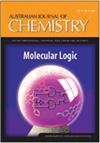采用一锅法合成非极性功能化硅氧烷颗粒,实现粒径控制的方法
IF 0.9
4区 化学
Q4 CHEMISTRY, MULTIDISCIPLINARY
引用次数: 0
摘要
均相添加功能硅烷溶解在乙醇等共溶剂中,已被证明可以改变颗粒的生长机制,以及对颗粒大小和分散性的控制,特别是对非极性硅烷。从50到超过1000nm的高度单分散的硅颗粒,具有巯基、乙烯基、苯基、丙基、氰丙基和氯丙基的R基团功能,直接从相应的单一有机硅烷源合成。随着时间的推移,对颗粒生长的观察表明,它是通过传统的Stöber过程进行的,其中硅烷单体和低聚物添加到成核位置,导致颗粒生长。均匀混合方法的放大产生克数量的颗粒,而不影响尺寸,尺寸分散或良好混合下的功能。通过在颗粒合成液中简单的第二次添加反应分子,证实了表面R基团的存在和功能,从而得到理论最大附着密度。本文章由计算机程序翻译,如有差异,请以英文原文为准。
Approach to achieve controlled particle size synthesis of non-polar functionalised siloxane particles using a one-pot synthesis
The homogeneous addition of functional silanes dissolved in a co-solvent such as ethanol has been shown to change particle growth mechanisms as well as control over particle size and dispersity, especially for non-polar silanes. Highly monodisperse size-controlled silica particles from 50 to over 1000nm bearing thiol, vinyl, phenyl, propyl, cyanopropyl and chloropropyl R group functionality were synthesised directly from the corresponding single organosilane source. Observing particle growth over time revealed that it proceeded by a conventional Stöber process, where silane monomers and oligomers add to nucleation sites, resulting in particle growth. Scale-up of the homogeneous mixing approach produced gram quantities of particles without affecting size, size dispersion or functionality under good mixing. The presence and functionality of the surface R groups were confirmed by a simple second addition of reactive molecules to the particle synthesis liquor, resulting in theoretical maximum attachment densities.
求助全文
通过发布文献求助,成功后即可免费获取论文全文。
去求助
来源期刊

Australian Journal of Chemistry
化学-化学综合
CiteScore
2.50
自引率
0.00%
发文量
65
审稿时长
1.3 months
期刊介绍:
Australian Journal of Chemistry - an International Journal for Chemical Science publishes research papers from all fields of chemical science. Papers that are multidisciplinary or address new or emerging areas of chemistry are particularly encouraged. Thus, the scope is dynamic. It includes (but is not limited to) synthesis, structure, new materials, macromolecules and polymers, supramolecular chemistry, analytical and environmental chemistry, natural products, biological and medicinal chemistry, nanotechnology, and surface chemistry.
Australian Journal of Chemistry is published with the endorsement of the Commonwealth Scientific and Industrial Research Organisation (CSIRO) and the Australian Academy of Science.
 求助内容:
求助内容: 应助结果提醒方式:
应助结果提醒方式:


